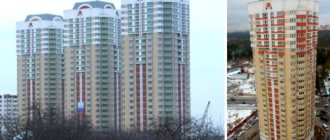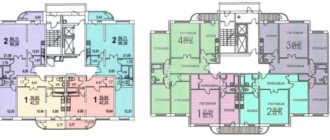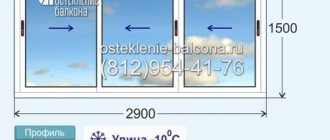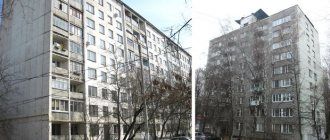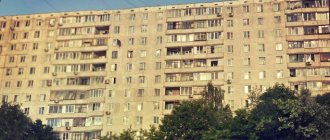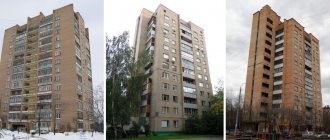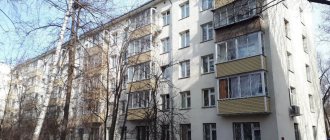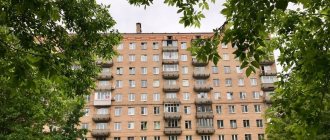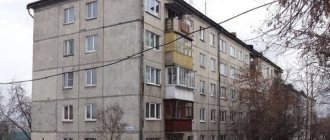The P-22 series of panel houses, designed by MNIITEP, did not become widespread, although within the framework of the project three of its modifications were created, which began to be designated as independent series:
- P-22/16 - for use as part of a standard residential development with 12-16 floors.
- P-22/25 – modification of increased number of floors (23-25 floors).
- P-22K is a 23-story cruciform building with an extended pitch of load-bearing structures.
The P-22 project was not used for mass housing construction in new areas - it turned out to be more convenient for spot urban development.
The series was also used as corner and central elements of combined residential buildings, where entrances of other standard projects (usually P-3) were added to sections P-22.
The construction of the P-22 series and its modifications was discontinued for economic reasons - the cost per square meter turned out to be significantly higher than that of other panel projects.
P-22K
The largest number of houses were built in the P-22K version, since their cruciform shape made it possible to diversify the architectural appearance of the city.
The P-22K series, which has become the most widespread, can be considered the most improved version. This modification was built in Moscow from 1982 to 1987.
Houses P-22K
The addresses of all the houses in the series are known: 2 Osenniy Boulevard, Barvikhinskaya Street. 4 (buildings 1 and 2), Rublevskoe highway 44 (buildings 1 and 2), st. Koshtoyantsa houses 6 and 10.
The most interestingly designed cruciform houses on the street. Koshtoyants - to the buildings of the P-22K series as the central cores, side “wings” are attached, corresponding to the P-3 project.
On the same street (Koshtoyantsa 2) a cruciform house was built in a similar way, where the central part belongs to the P-4 series.
Layout of the P-22K series
In P-22K houses, the distance between the load-bearing walls has been increased and one staircase has been added to each entrance.
Description and infrastructure
The elegant building of the “White Swan” consists of three sections of variable number of storeys (14-15-16). The technical equipment of the house meets all European standards. a three-level parking in the underground part
, designed for
202 parking spaces
, there is a surface guest parking lot.
The complex has all the conditions for walking and sports activities - there are flower beds everywhere, alpine slides, benches and decorative lanterns, and jogging paths.
The White Swan residential complex attracts buyers with its high-quality infrastructure: a kindergarten and a private school, a multifunctional gym, and a seawater swimming pool.
On the ground floors there are shops, a restaurant, a mini-cafe, a bank branch, cosmetic and dental offices. Series 1-MG-300
The series of five-story houses 1-MG-300 is a series invented as a replacement for the II-32 and K-7 series, just like the ancestor series 1-MG-300 is being demolished. There are several modifications of the series with different layout options. The very first 1MG-300 were built in 1963-65. in the 10th quarter of New Cheryomushki. A total of 261 thousand square meters (63 houses) were built. They were built en masse in the Rechnoy Vokzal metro area.
Characteristics of 1-mg-300:
Type of house - panel Number of floors - 5 Apartments - 1,2,3,4 rooms Floor height from floor to floor - 2700mm External panels are expanded clay concrete or three-layer Floors per room 140mm thick Developer - Mniitep. Manufacturer - DSK-1 There is a garbage chute. Years of construction: 1963-1968 Cities of distribution: Moscow, Pavlovsky Posad
Series 1-mg-600
This series was built on a fairly small scale and is represented in Moscow by three compact microdistricts. However, based on it, the MG-601 series appeared, which is found quite often...
Characteristics of the 1-mg-600 series:
Type of house - frame-panel Number of storeys - 9 Height of residential premises - 264 cm Apartments - 1,2,3 rooms
Elevator, garbage chute, gasified. Distribution cities: Moscow (Cheryomushki, Nagatino), Khimki
Typical apartment layouts in 1-mg-600 (placement on the floor):
Series 1-MG-601
Buildings of the 1-MG-600.601 series are the first truly mass-produced frame-panel residential buildings with a full frame. The series uses a special design of load-bearing walls: they go in increments of 6 meters + columns (40 by 40 cm) in increments of 4.5 m. On the ground floor there are areas for storing bicycles, strollers, and skis. The houses were built in the mid-to-late 60s and were hyper-comfortable for their time. Moreover, several similar houses in the center belonged to the Central Committee, for small fry it is true, but still.
The first versions of MG601 had a rectangular plan
Then they acquired the familiar zigzag one (modification 1-MG-601-ZH)
General characteristics of the 1-MG-601 series:
Number of floors - 16-19
Manufacturer - MPSM (Mospromstroymaterialy) Years of construction - 1965-1975 Cities of distribution - Moscow Height of residential premises - 248 cm / 264 cm Building structures: Frame. Columns 40x40, with a hidden console. Grid -6x4.5 and 4.5x2 meters
The outer walls are 34 cm thick expanded clay concrete; Floor slabs - 14 or 16 cm reinforced concrete, solid; Apartments: 2, 3 and 4 rooms, living area of two-room apartments 26.5 sq.m. , three-room apartments - 38 or 39 sq.m., four-room apartments - 49.6 sq.m. Elevators/garbage chute: passenger and cargo/passenger/valve on each floor. The roof is attic.
The 1-mg-601 series includes a large number of modifications, their names are written under the photographs and layouts.
modification 1-mg-601-D
modification 1-MG-601-E
1-MG-601-D non-standard colors
Apartment layout options:
Photo of the house from the “Swan” series
Characteristics of the “Swan” series of houses:
Type of house - frame-panel Number of floors - 16.20 Height of living quarters - 270 cm Frame. Columns 40x40, with a hidden console. Grid - 6x4.5 meters Crossbar - T-bar 45x40 with a shelf for supporting the floor panels. The rigidity diaphragms are 14 cm thick, longitudinal and transverse.
Apartments - 1,2,3,4 rooms Manufacturer - MPSM Years of construction - 1966-2003 Cities of distribution - Moscow (mainly northern areas of the city)
Typical options for facades and layouts in the “Swan” series of houses:
"Late" version of "Swan"
Useful links:
Previous episodes: 44.
Serviced house complex / experimental residential complex “Swan”
Architects: A. Meyerson (leader of the design team), E. Podolskaya, A. Repety, I. Fedorov (workshop No. 2, Mosproekt-1) Engineers: B. Lyakhovsky, A. Gordon, D. Morozov, V. Samodov Address: Moscow, Leningradskoe shosse, 29-35 Years of construction: 1967-1973
Mikhail Knyazev, architect of the Hora bureau and co-founder of the Sovmod project:
“In 1973, on the Leningradskoye Shosse in Moscow, the construction of a “serviced house-complex” was completed. Its other name, under which it entered the history of Russian architecture, is the Lebed residential complex.
This house became the dominant feature of the experimental microdistrict of the same name that was being created in those years in the north-west of the capital. This is how architect Elena Podolskaya, one of the authors of the project, described it: “The detailed planning project for the microdistrict provides for the construction of 9-, 16- and 30-story residential buildings, as well as a large shopping center, a school and kindergartens. The ensemble of the microdistrict, the silhouettes of the buildings of which will appear above the pines of the Pokrovskoye-Glebovo Park, will serve as the compositional beginning of the huge new urban district of Khimki-Khovrino. A characteristic feature of “The Swan” is its well-known isolation and isolation. We are talking about the lack of direct connections with other microdistricts. After all, the rest, or rather the main area of the Khimki-Khovrino massif, is located on the opposite side of the Leningradskoye Highway and somewhat further from the center of Moscow.” (E. Podolskaya. House-complex with services // Construction and architecture of Moscow, No. 1/1968).
Representatives from various fields were involved in the design - economists, statisticians, sociologists. The result of the joint work of architects under the leadership of Andrei Meyerson and invited specialists was the division of the population of the future microdistrict into groups, or, as the study participants themselves called them, “collectives.” The authors of the project believed that such differentiation of residents into groups that were planned to be housed in different conditions would help create an optimal scheme for serving the population and establish the characteristics of a new format of housing. The architects considered the Lebed complex, reserved for the residence of “team No. 3,” as the most important part of a large experiment.
The volumetric-spatial composition of the “Swan” consists of four 16-story buildings, three of which (buildings No. 4, 5 and 7) have two sections and are located closer to the Khimki reservoir, and a single-section tower (building No. 6) is pushed to the red building line highway. An important role in determining the final location of the buildings was played by insolation, fire safety and sanitary requirements individually calculated for each house.
All volumes stand on the stylobate of the service block, where a spacious lobby with a wardrobe and vending machines, an ordering desk, dry cleaning and laundry, a rental point for household appliances, a medical room, a kindergarten-nursery for 140 places, a conference room, clubs, workshops, library and much more. This set of functions was supposed to provide residents of Lebed with, if not an autonomous existence within the complex, then at least create a high level of service for those times and the most comfortable living conditions.
The exploited roof of the stylobate had a recreational function: residents could spend time outdoors and even play sports on it. In the underground part of the complex, the architects provided a cooperative parking garage with 300 parking spaces, storage rooms for each apartment and a group of technical rooms.
A person who moved into Lebed received an apartment with an improved layout, a number of technical characteristics of which distinguished it from any other Soviet apartment. High ceilings (2.7 m when clean), large kitchens, spacious rooms and utility rooms, a system of built-in wardrobes, loggias of impressive size - all this corresponded to the idea of a new type of home.
The facades of the complex, despite its high-quality content, differed little from the solutions used for mass residential development: for the external decoration of residential volumes, the usual suspended expanded clay concrete panels with roughly sealed seams were chosen. The simplicity of the external decoration of the residential buildings is compensated by the successful rhythm of the location of the loggias, which gives the facades the necessary plasticity. The walls of the service block are made of red brick, effectively combined with rough reinforced concrete surfaces. The sharp contrast of the Swan with the surrounding landscape enhances the perception of its architecture and adds even greater expressiveness to the sharp forms of the ensemble.
For the “Swan” project, the architect Meyerson, who a few years later built the famous one on Begovaya, received the Grand Prix in Paris. Regardless of whether the ambitious experiment ended in absolute success, we can say that the architects competently solved a number of difficult problems, and “Swan,” the pearl of the experimental microdistrict of the same name, deserves respect and is worthy of special protective status.”
On Vorobyovy Gory, at the intersection of Michurinsky and Universitetsky Avenues, a premium residential complex “White Swan” was built. A favorable ecological situation due to the proximity of a natural reserve, combined with a convenient location relative to main avenues, are far from the only advantages of the White Swan residential complex.
The elegant 16-storey building, with high-tech equipment, is an excellent example of modern architectural style. The apartments, oriented on two and three sides, have excellent views. The upper level of the house is occupied by penthouses with terraces of up to 400 square meters. m.
In terms of diversity and quality of infrastructure, the residential complex is not inferior to other elite properties; everything here is thought out to the smallest detail. The ratio of the number of places in the underground park exceeds the number of apartments by one and a half times.
Improvement
The territory has designated areas for surface parking and a children's playground. There is a walking area - it is decorated with flower beds, alpine slides, garden sculpture and decorative lanterns.
Houses P-22/16
The buildings of the P22-16 series created a new look for several capital squares (for example, Sokolnicheskaya).
Houses P-22/16
Construction of this option began in 1971 and was completed in 1991, but their number is not large.
Layout example of the P-22/16 series
Panel houses P-22/25
Basically, this modification of the P-22 series was built in the form of separate towers, with two entrances in each. Such houses can be found in the Northern Chertanovo area.
Panel towers P-22/25
Less commonly, P-22/25 buildings were built into the buildings of residential complexes (for example, in Nagatino).
Residential development in Nagatino
Houses P-22/25 were built only in Moscow Apartments from 1982 to 1984.
Example of floor layout of the P-22/25 series
Features of apartment layouts
The standard layout of a 3-room apartment has built-in wardrobes and mezzanines. In addition, the advantages of standard houses of the II-57 series include isolated rooms and separate bathrooms. But the kitchens in the houses of the series remain small. A positive aspect of the II-57 series was the reduction in the number of load-bearing walls - there were significantly more options for redevelopment.
Apartments in houses of the P-22 series
All apartments in these projects have 1, 2, and 3 rooms and have a ceiling height that is standard for panel Brezhnevok - 264 cm.
Kitchens and rooms are quite spacious for their time, which cannot be said about non-residential areas.
There are several options for apartment layouts, including those with dark rooms (closets) and varying numbers of balconies.
| Apartment area (m²) | General | Residential | Kitchen |
| 1 room | 35-39 | 17-22 | 8-9 |
| 2-room | 54-55 | 34-37 | 8-9 |
| 3-room | 74-77 | 45-48 | 8-9 |
In one-room apartments the bathrooms are adjacent, in the rest - separate.
Main features of houses
The buildings have one entrance and 6 apartments per floor. A total of 2 elevators: for passengers 400 kg, for passengers and cargo 630 kg. The staircase has a smoke-free system. There is a garbage chute, loading on each floor.
The houses of the “Swan” series have the following distinctive features:
- the presence of a balcony or loggia in each apartment;
- average ceiling height – 2.7 m;
- organized natural ventilation in the house, ventilation units in the kitchen and bathroom;
- the bathroom is separated from the toilet, the bathtub is standard, 170 cm long;
- medium-sized kitchens, from 9 to 13 m².
The apartments are spacious, the layout includes apartments with 1, 2, 3 and 4 rooms. Average apartment area:
- one-room apartments – 40 m²;
- two-room apartments – 50 m²;
- three-room apartments – 80 m²;
- four-room apartments – 90-100 m².
The apartments are isolated and have a comfortable layout. Owners, however, have great opportunities for redevelopment; standard redevelopments of houses in the “Swan” series are in great demand.
Design and features of the P-22 series
The external walls of the series buildings are made of three-layer panels, with insulation between two layers of concrete.
Load-bearing interior and inter-apartment walls are assembled from reinforced concrete panels 14-18 cm thick. The ceilings are also made from reinforced concrete panels.
Interior partitions are made of gypsum concrete slabs 8-10 cm thick.
At the entrances there is one passenger elevator and, depending on the number of floors, there are one or two freight-passenger elevators.
Characteristics of the II-08 series
All houses in the series are brick, rectangular in shape without rotating sections.
The first floors could be residential or designed to house shops (less often, organizations).
- The external walls of houses of the type II-08 series have a brickwork thickness of about 65 cm, and the internal walls are 34-52 cm.
- Interior partitions - gypsum concrete slabs or blocks, 8 cm thick.
- The floors are prefabricated, made of reinforced concrete round-hollow slabs 22 cm thick.
The number of apartments on the floor is 3 or 4.
Sample Floor Plan Series II-08
The load-bearing walls are the external walls, the longitudinal wall in the center of the building, as well as the transverse inter-apartment and staircase walls.
The houses have dark sand brick facades, which can be plastered and painted in different colors during renovation.
